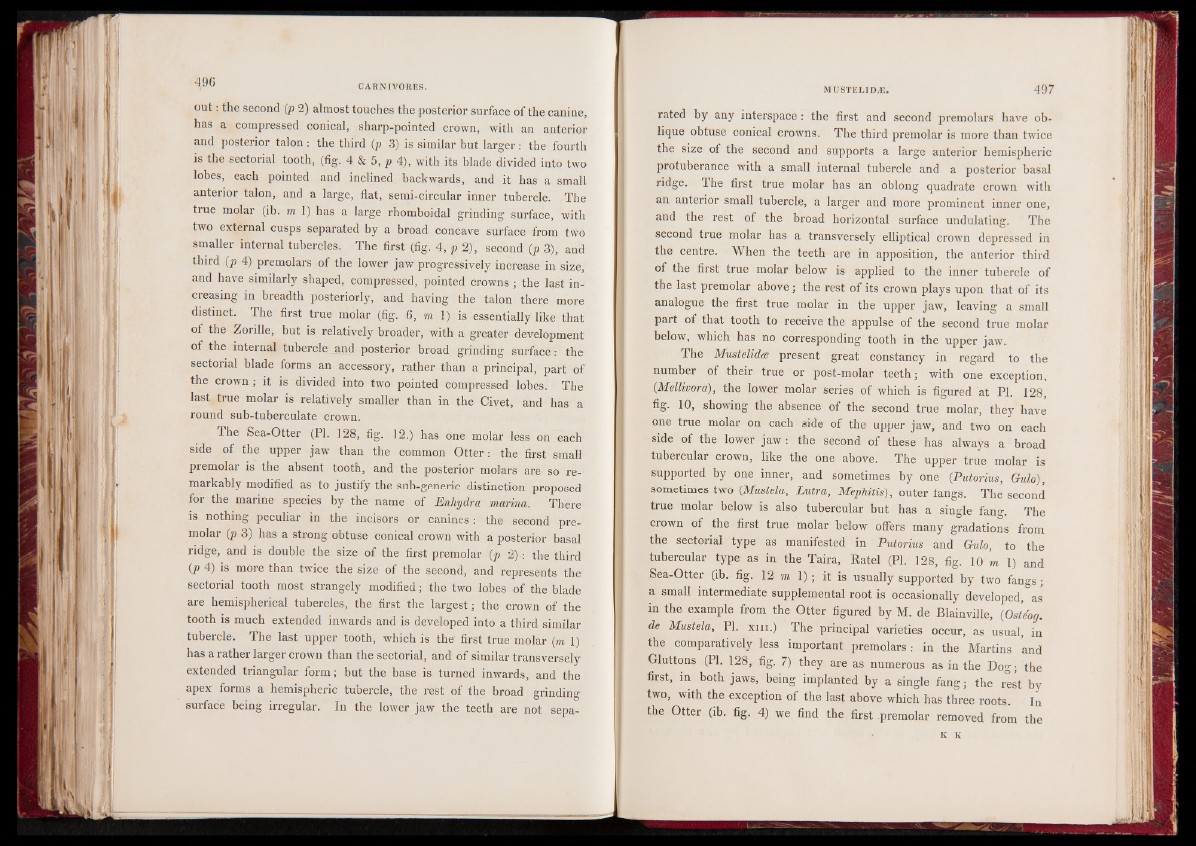
out: the second (p 2) almost touches the posterior surface of the canine,
has a compressed conical, sharp-pointed crown, with an anterior
and posterior talon: the third (p 3) is similar but larger: the fourth
is the sectorial tooth, (fig. 4 & 5, p 4), with its blade divided into two
lobes, each pointed and inclined backwards, and it has a small
anterior talon, and a large, flat, semi-circular inner tubercle. The
true molar (ib. m 1) has a large rhomboidal grinding surface, with
two external cusps separated by a broad concave surface from two
smaller internal tubercles. The first (fig. 4, p 2), second (p 3), and
third (p 4) premolars of the lower jaw progressively increase in size,
and have similarly shaped, compressed, pointed crowns ; the last increasing
in breadth posteriorly, and having the talon there more
distinct. The first true molar (fig. 6, m 1) is essentially like that
of the Zorille, but is relatively broader, with a greater development
of the internal tubercle and posterior broad grinding surface: the
sectorial blade forms an accessory, rather than a principal, part of
the crown ; it is divided into two pointed compressed lobes. The
last true molar is relatively smaller than in the Civet, and has a
round suh-tuberculate crown.
The Sea-Otter (PI. 128, fig. 12.) has one molar less on each
side of the upper jaw than the common O tter: the first small
premolar is the absent tooth, and the posterior molars are so remarkably
modified as to justify the sub-generic distinction proposed
for the marine species by the name of Enhydra marincir. There
is nothing peculiar in the incisors or canines: the second pre-
molar (p 3) has a strong obtuse conical crown with a posterior basal
ridge, and is double the size of the first premolar (p 2): the third
(p 4) is more than twice the size of the second, and represents the
sectorial tooth most strangely modified; the two lobes of the blade
are hemispherical tubercles, the first the largest; the crown of the
tooth is much extended inwards and is developed into a third similar
tubercle. The last upper tooth, which is the first true molar (m 1)
has a rather larger crown than the sectorial, and of similar transversely
extended triangular form; but the base is turned inwards, and the
apex forms a hemispheric tubercle, the rest of the broad grinding
surface being irregular. In the lower jaw the teeth are not separated
by any interspace: the first and second premolars have oblique
obtuse conical crowns. The third premolar is more than twice
the size of the second and supports a large anterior hemispheric
protuberance with a small internal tubercle and a posterior basal
ridge. The first true molar has an oblong quadrate crown with
an anterior small tubercle, a larger and more prominent inner one,
and the rest of the broad horizontal surface undulating. The
second true molar has a transversely elliptical crown depressed in
the centre. When the teeth are in apposition, the anterior third
of the first true molar below is applied to the inner tubercle of
the last premolar above ; the rest of its crown plays upon that of its
analogue the first true molar in the upper jaw, leaving a small
part of that tooth to receive the appulse of the second true molar
below, which has no corresponding tooth in the upper jaw.
The Mustelidce present great constancy in regard to the
number of their true or post-molar teeth; with one exception,
(Mellivora), the lower molar series of which is figured at PL 128,
fig. 10, showing the absence of the second true molar, they have
one true molar on each side of the upper jaw, and two on each
side of the lower jaw : the second of these has always a broad
tubercular crown, like the one above. The upper true molar is
supported by one inner, and sometimes by one (Putorius, Gulo),
sometimes two (Mustela, Lutra, Mephitis), outer fangs. The second
true molar below is also tubercular but has a single fang. The
crown of the first true molar below offers many gradations from
the sectorial type as manifested in Putorius and Gulo, to the
tubercular type as in the Taira, Ratel (PI. 128, fig. 10 m 1) and
Sea-Otter (ib. fig. 12 m 1); it is usually supported by two fangs;
a small intermediate supplemental root is occasionally developed, as
in the example from the Otter figured by M. de Blainville, (Oste'og.
de Mustela, PI. xm.) The principal varieties occur, as usual, in
the comparatively less important premolars: in the Martins and
Gluttons (PI. 128, fig. 7) they are as numerous as in the Dog; the
first, in both jaws, being implanted by a single fang; the rlst by
two, with the exception of the last above which has three roots. In
the Otter (ib. fig. 4) we find the first .premolar removed from the
K K